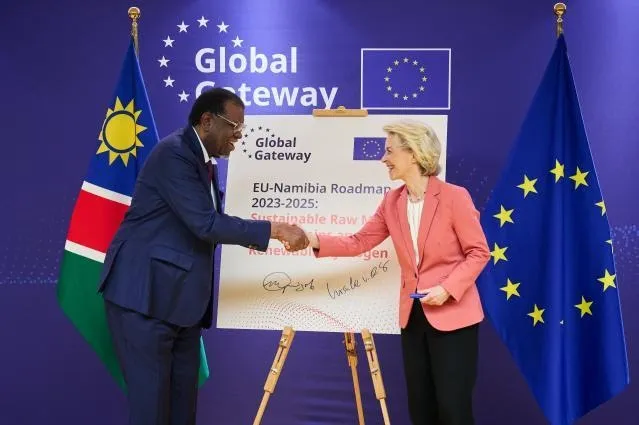Namibia and the EU have endorsed the roadmap for the EU–Namibia strategic partnership on sustainable raw materials value chains and renewable hydrogen, supported by €1 billion in investments by the EU, its Member States and European financial institutions.
As part of this roadmap, the EU will also support an upcoming study for the development of the Walvis Bay port, the entry point from the Atlantic side to the Walvis Bay – Maputo Corridor, one of the eleven Strategic Corridors the EU envisages supporting as part of the EU-Africa Global Gateway Investment Package.
Its location makes it a natural gateway for international trade to the Southern African Development Community, a region with over 300 million inhabitants, the Union said.
“The expansion of the port of Walvis Bay to cater for the development of the emerging green hydrogen industry is a demonstration of mutually beneficial Global Gateway cooperation. We are strengthening sustainable value chains and strategic transport corridors in Africa and delivering on the green and digital transitions in both Namibia and the EU. The Roadmap adopted today is a tangible follow up to January’s discussions in Windhoek. It gives Team Europe members the framework to identify projects with high potential, mobilise investments and boost skills training along the renewable hydrogen and raw materials value chains,” said Jutta Urpilainen, Commissioner for International Partnerships.
With EU support, the Port of Antwerp and Bruges International will develop a masterplan that covers multimodal infrastructure, spatial planning and market organisation for the Port of Walvis Bay to carry out this transformation and become a regional logistics and industrial hub for the green hydrogen and derivatives economy. The EU will also support the Namibian Ports Authority in achieving operational excellence.
In November 2022, Namibia and the EU signed a Memorandum of Understanding establishing a strategic partnership on Sustainable Raw Materials Value Chains and Renewable Hydrogen. The operational roadmap, launched and endorsed last week and for the upcoming period 2023–2025, details the concrete actions in which the partnership will advance its goals, in close cooperation with EU and Namibia financial and private sector stakeholders.
The actions in the roadmap follow the six pillars of the Memorandum of Understanding:
- Integration of value chains, including by working with the industry to identify, promote and facilitate cooperation in the exploration and commercial development of critical raw material projects.
- Cooperation to leverage environmental, social and governance criteria, including by mapping and assessing abandoned mines and supporting Namibia in using Earth Observation and remote sensing methods for resource exploration, land use planning and management.
- Mobilising funding for soft and hard infrastructure, including for selected mining, refining and mineral green processing projects (water, rail, renewable energy) and for the upgrade of main transport corridors (port, rail, roads).
- Capacity building, training and skills development, including identifying training and skills needs along the raw material and green hydrogen value chains and enhancing the relevant technical and vocational training offer by Team Europe in cooperation with the industry.
- Co-operation on research and innovation, including facilitating studies and joint research projects and research and business networking along the entire critical raw material value chain.
- Regulatory alignment, including supporting Namibia in developing a national strategy for critical raw materials and enacting a synthetic fuels act to create an enabling environment for hydrogen and synthetic fuels industry, and ensure compatibility with international green fuels, certification and standards.
“The roadmap we are endorsing today represents what our partnership is about – concrete industrial projects that will benefit both the EU and Namibian economies, by promoting the integration of raw materials value chains. These projects offer Namibia a distinctive opportunity to develop raw materials value chains while supporting the resilience of the EU industry,” Thierry Breton, Commissioner for Internal Market.
Echoing these views Commission President Ursula von der Leyen said: “Thanks to its abundant renewable energy potential, Namibia is becoming a front-runner in the green hydrogen space. The EU is proud to be a partner in this transformative journey towards green industrialisation. Together we can further decarbonise our economies, create jobs and ensure a more prosperous and greener future for our societies.”
President of Namibia Hage Geingob said: “Namibia recognises that its world-class renewable energy resources provide a strong foundation upon which we will build a sustainable and impactful green industrial base. Namibia is also cognisant that to fully capture the opportunity at hand, we will have to mobilise fit for purpose capital that appropriately prices risk in order to optimise the cost of said capital. This is a key element that will form the cornerstone of this transformative partnership with the EU.”
The European Union, with the European Investment Bank and Member States including Germany, Netherlands, France, Belgium and Finland, in a Team Europe approach, supports Namibia’s green recovery in line with the “Harambee Prosperity Plan II”, “Vision 2030”, and the Global Gateway strategy. The actions of the partnership build on Namibia’s commitment to the green transition.



Leave a Reply